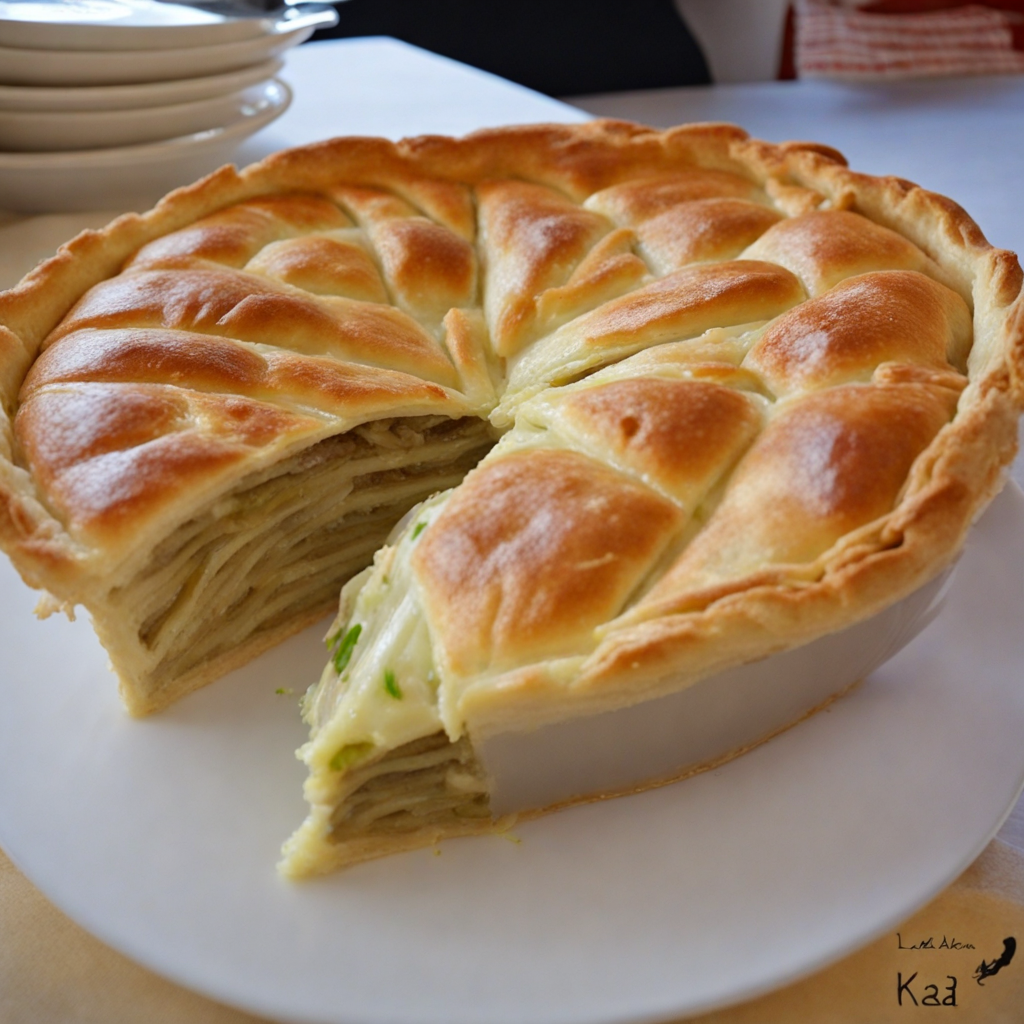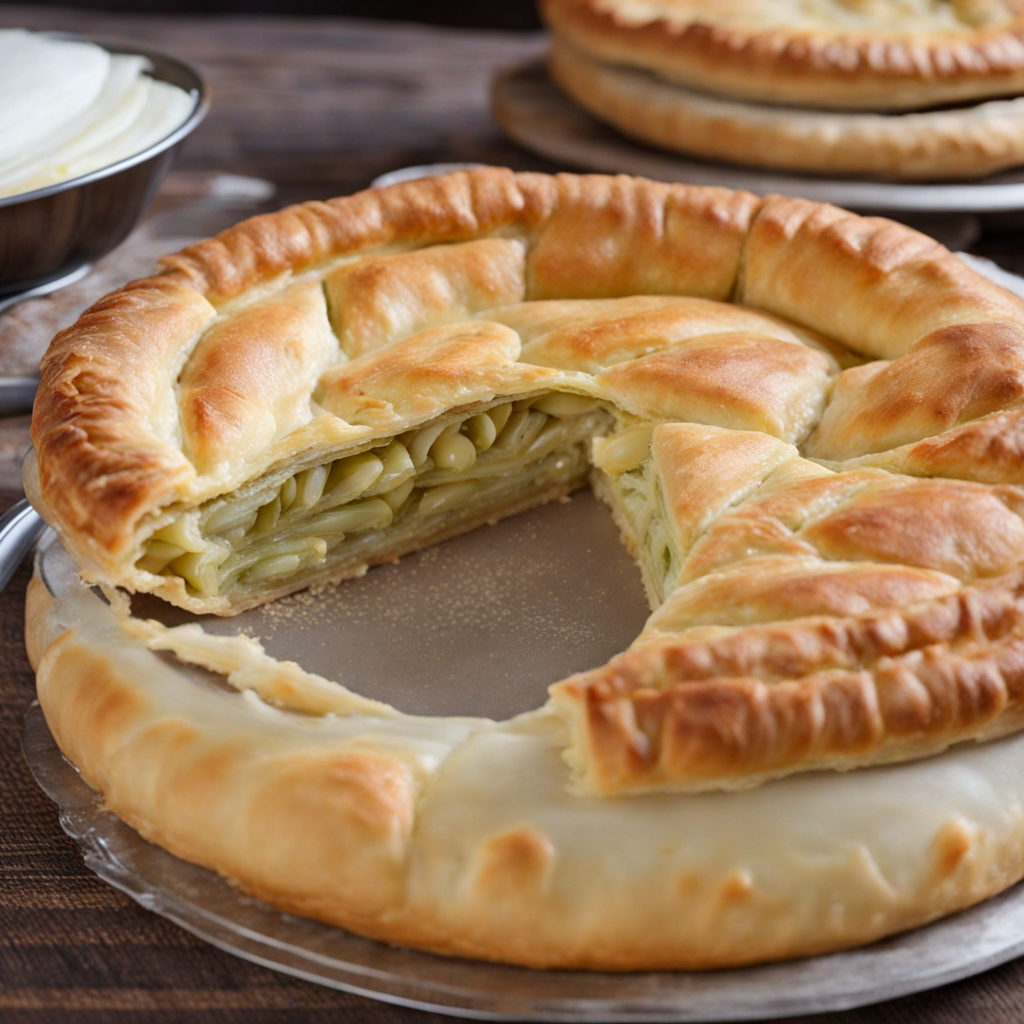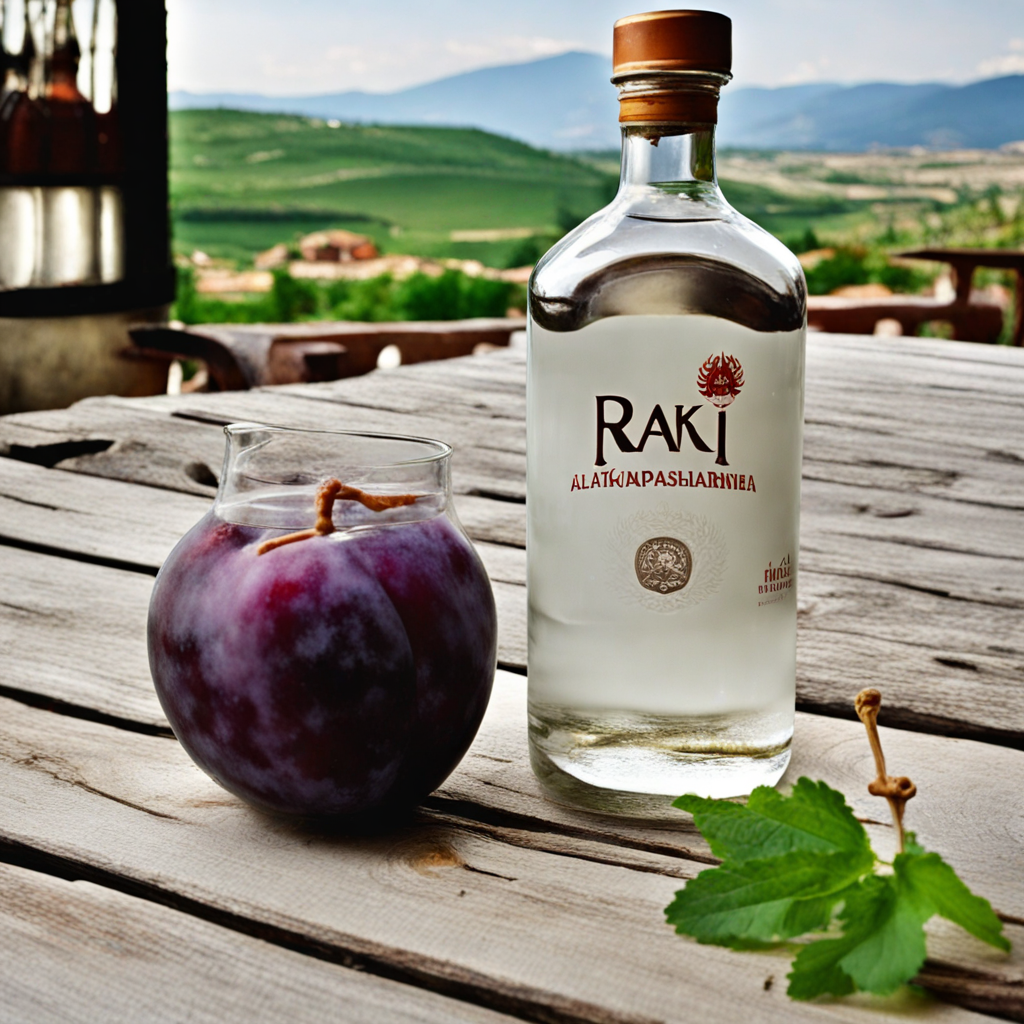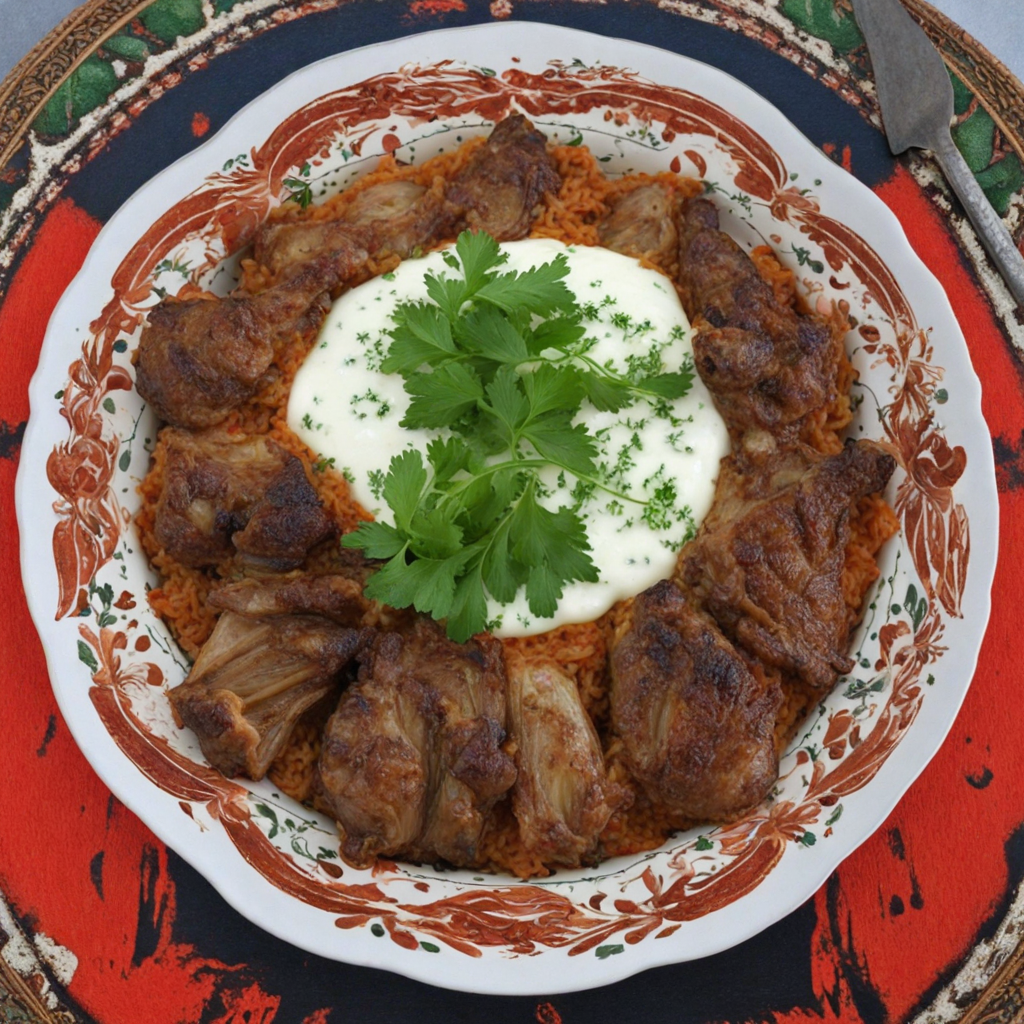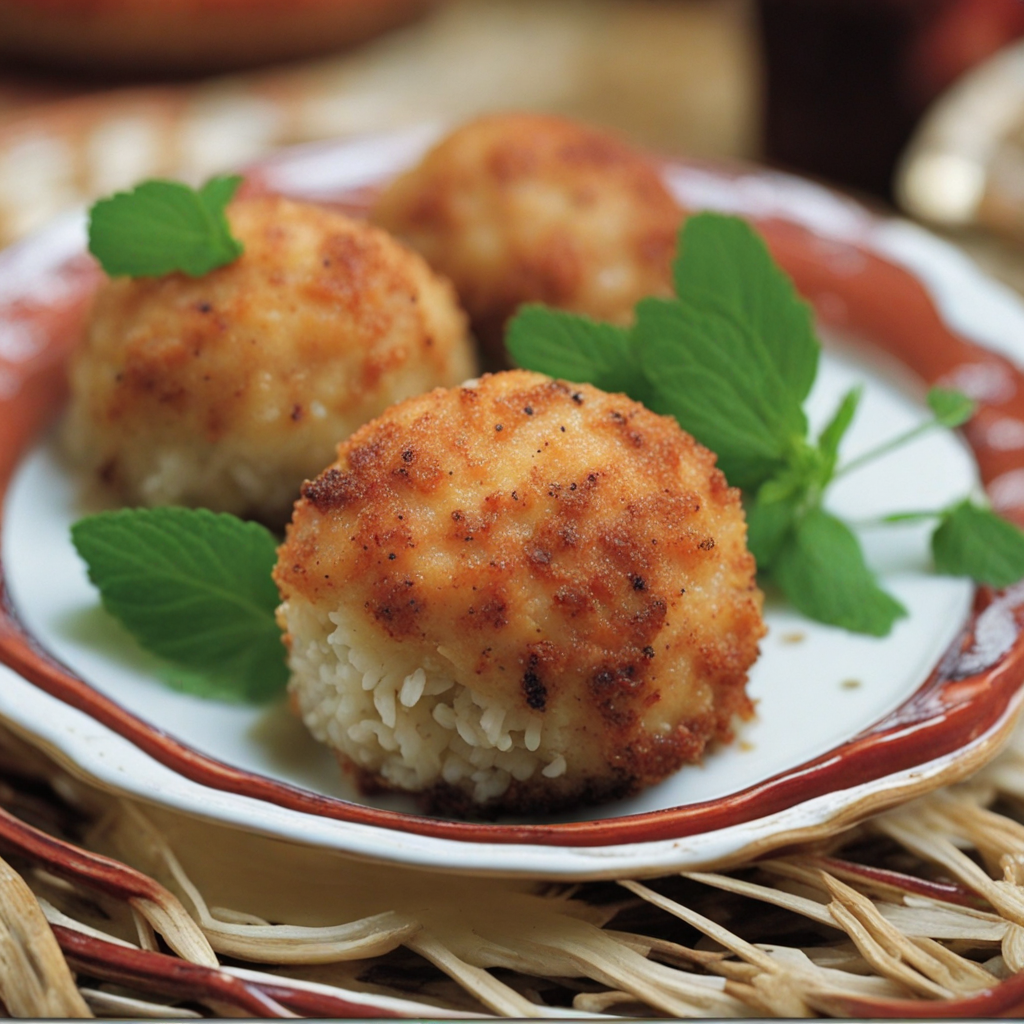Lakror
Lakror is a traditional Albanian dish that embodies the essence of homemade comfort food, often compared to a savory pie. This delightful dish consists of layers of thin, flaky dough, which is typically made from flour, water, and salt. The dough is stretched and layered, creating a delicate texture that, when baked, becomes wonderfully crispy. The filling usually features a harmonious blend of seasonal vegetables, such as spinach, chard, or leeks, and can also include cheese or minced meat, making it versatile and suitable for both vegetarian and meat-lover preferences. One of the most charming aspects of Lakror is its regional variation. In different parts of Albania, cooks may add their unique twists, such as incorporating herbs like dill or parsley, which infuse the dish with fresh, aromatic flavors. The pie is typically baked in a round shape, yielding a golden-brown crust that is both visually appealing and satisfying to bite into. The contrast between the crispy exterior and the tender, flavorful filling creates a delightful experience for the palate. Served warm, Lakror is often accompanied by a yogurt-based sauce or a simple salad, enhancing its taste and providing a refreshing balance. This dish is not only a staple in Albanian homes but has also found its way into the hearts of food lovers around the world. For those looking to explore new culinary horizons, Lakror offers a taste of Albania’s rich cultural heritage and a comforting fusion of textures and flavors that is sure to leave a lasting impression.
How It Became This Dish
Lakror: A Culinary Tradition of Albania Lakror, a quintessential dish of Albanian cuisine, embodies the essence of the country’s culinary heritage and its rich cultural tapestry. This traditional savory pie, made primarily with layers of thin dough and various fillings, showcases a deep-rooted history that intertwines with Albania's social and cultural evolution. To understand Lakror fully, we must explore its origins, significance, and development over time. Origins The roots of Lakror can be traced back to the Ottoman Empire, which exerted a profound influence on the culinary practices of the Balkans. The Ottomans introduced various types of pastries and baked goods, which evolved and adapted to local ingredients and tastes. In Albania, the concept of layered pies likely originated from these influences, yet it has since developed its own identity. The word "Lakror" itself comes from the Albanian language and is thought to derive from the Turkish word "lahmacun," referring to a flatbread. However, while lahmacun is typically topped with spiced meat, Lakror has diversified to include an array of fillings, reflecting the agricultural bounty of Albania. Historically, Lakror was made using simple, local ingredients – flour, water, and salt for the dough, and a variety of fillings such as wild greens, cheese, or even meat. The use of seasonal vegetables and foraged greens like dandelions, nettles, and chard highlights the close relationship between Albanian culinary practices and the land. Cultural Significance Lakror is more than just a dish; it is a symbol of Albanian identity and communal life. Traditionally, making Lakror is often a communal activity, bringing families and friends together. In rural areas, the preparation would typically involve women gathering to make the dough and filling, sharing stories and laughter as they worked. This practice emphasizes the importance of community and the transmission of cultural knowledge from one generation to the next. During special occasions, such as weddings, religious holidays, and celebrations, Lakror takes center stage. It is often served as part of a festive meal, showcasing the host's culinary skills and hospitality. The dish is associated with abundance and generosity, as it can be made in large quantities to feed many guests. Moreover, Lakror carries a sense of nostalgia and comfort for Albanians. It evokes memories of home and family gatherings, and even today, many Albanians living abroad cherish the dish as a connection to their homeland. The preparation and enjoyment of Lakror often involve rituals that honor family traditions, underscoring its role in cultural continuity. Development Over Time As Albania underwent significant political and social changes throughout the 20th century, so too did the preparation and consumption of Lakror. During the communist regime (1944-1991), traditional practices were often suppressed, and the emphasis was placed on uniformity rather than diversity. Nevertheless, Lakror persisted as a beloved dish, particularly in rural areas where traditional cooking methods were maintained. In the post-communist era, Albania experienced a resurgence of interest in its culinary heritage. Chefs and home cooks alike began to explore traditional recipes with a renewed vigor, often experimenting with new ingredients or modern cooking techniques. The revival of Lakror as a focal point of Albanian gastronomy was part of a broader movement to reclaim and celebrate national identity. Today, Lakror is not only enjoyed in homes but has also found its way into restaurants and cafes across Albania and among the Albanian diaspora. It is often featured on menus as a representation of authentic Albanian cuisine, drawing in locals and tourists alike who seek to experience the flavors of Albania. The dish has also adapted to contemporary culinary trends, with variations that cater to diverse palates, including vegetarian and vegan options. Variations and Regional Differences One of the most fascinating aspects of Lakror is its regional variations. In the north of Albania, the filling may lean towards heartier ingredients such as minced meat and potatoes, while southern regions might favor lighter fillings like greens and herbs. In coastal areas, seafood can also find its way into Lakror, showcasing the rich maritime resources of the Albanian Riviera. Furthermore, the method of preparation can vary significantly. While some choose to bake Lakror in a traditional wood-fired oven for that authentic smoky flavor, others may opt for modern baking techniques that yield a flaky, golden crust. Regardless of the approach, the core essence of Lakror as a labor of love and a vessel for local ingredients remains unchanged. Lakror in Contemporary Culture In contemporary Albania, Lakror is often celebrated as a symbol of culinary pride. Food festivals and cultural events frequently feature Lakror, emphasizing its role in Albanian gastronomy. Chefs may showcase their own takes on the dish, incorporating influences from Mediterranean and Balkan cuisines, yet always honoring the traditional roots that make Lakror so special. Social media has also played a significant role in popularizing Lakror beyond Albania's borders. As images of this delightful pie circulate online, interest in Albanian cuisine grows, inviting a new generation to discover and appreciate Lakror and its rich history. Conclusion Lakror is more than just a pie; it is a testament to Albania’s culinary resilience and cultural heritage. With its origins steeped in Ottoman influence and its evolution reflecting the changing tides of Albanian society, Lakror stands as a beloved dish that transcends generations. It is a reminder of the importance of community, family, and the connection to the land. As Albania continues to carve out its place in the global culinary landscape, Lakror will undoubtedly remain a centerpiece of its gastronomic identity, inviting all who taste it to savor the flavors of a rich and storied culture. From communal kitchens to modern restaurants, the legacy of Lakror is one of celebration, tradition, and love – a delicious thread woven into the fabric of Albanian life.
You may like
Discover local flavors from Albania


